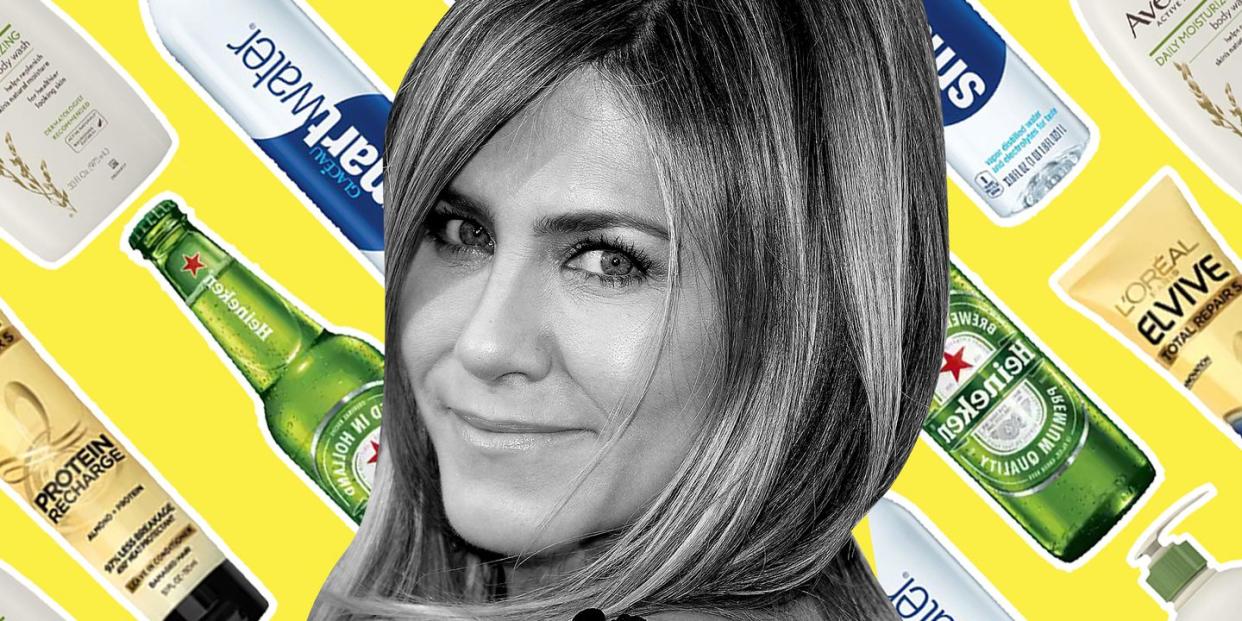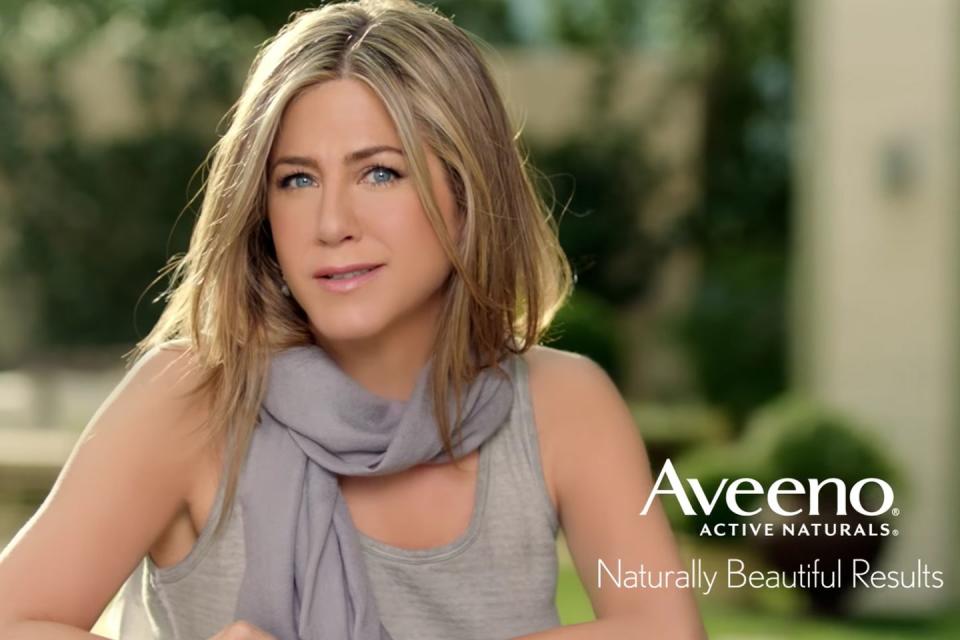The Business of Being Jennifer Aniston

Jennifer Aniston’s is the face that launched a thousand ad campaigns. The actress America first fell in love with for her performances on screens small and large has become even more ubiquitous in advertising: Flip through a magazine and you might see her clutching a bottle of Smartwater. Turn on the TV and find her espousing the positively radiant merits of Aveeno moisturizer; change the channel and there she’ll be again, this time encouraging you to talk to your doctor about what could very well be chronic dry eye.
Her business ventures are awfully lucrative, too. Though she is no longer making $1 million an episode on one of the most popular TV shows of all time-nor starring in the biggest box-office behemoths in the game-Forbes ranked Jennifer Aniston in second place (after Emma Stone) on the magazine’s 2017 list of highest-paid (movie) actresses, with an estimated income of $25.5 million. “I would estimate she makes over $10 million a year through her endorsements, easily,” says Forbes associate editor Natalie Robehmed. “It depends year to year, but that could be double what she earns from movies.” ($10 million is serious money: For reference, as reported by Variety, that’s the blockbuster paycheck Chris Pratt and Kevin Hart recently earned for Jurassic World: Fallen Kingdom and Jumanji: Welcome to the Jungle, respectively.) She’s also created six fragrances to date. (Jennifer Aniston’s publicist declined a request for comment for this story. Representatives for Smartwater, Aveeno, Eyelove, Emirates, and Living Proof also declined or failed to respond by press time.) Here’s how the household-name star of film and television-not to mention, unfortunately, tabloid covers-became a savvy titan of advertising.
Even though most of us don’t exactly have a close personal friendship with Jennifer Aniston, we nevertheless feel like we know celebrities. “When you see a celebrity that you recognize in an ad, you’re more likely to make a conscious decision to stop, listen, and see what they’re doing,” explains Chalcea Park, managing director of TMA Luxe, the “boutique atelier” of the agency The Marketing Arm, which evaluates and connects with celebrity talent on behalf of more than 150 brands (including eight of Forbes’ 13 “most valuable” brands). “Celebrities break through the tsunami of messages, images, and stimuli and help build an emotional connection to a brand.”
The industry term “borrowed equity” refers to the sneaky psychological osmosis by which brands hope that the associations consumers have with a celebrity spokesperson will be transferred onto the product itself. Besides the fact that she’s obviously beautiful (attractiveness being a valuable trait in just about any salesperson), funny, and charismatic, Aniston’s public persona has proven to be particularly sellable. “When I think of Jennifer Aniston, I think of an all-American girl. She seems very wholesome. She's authentic. I think of Rachel from Friends, because that's the character she played for so many years,” says Katie Kelting, assistant professor of marketing at St. Louis University. “She’s the quintessential girl next door, but she’s also aspirational,” Park says. Kelting suggests that Aniston’s aversion to social media only heightens her marketability. “She seems to have done a really good job about protecting her image in the public eye, even through all the drama that's happened in her personal life. We really only have what we see in the movies, or what we saw on television-we don't get to see her fire off a mean tweet,” she says.
And more importantly, people like her. A lot. The Marketing Arm’s Celebrity DBI is a database that rates celebrities’ awareness among the public, appeal, and other attributes based on a survey of 1,000 U.S. consumers. 94% of respondents were aware of Aniston, a score that puts her in 52nd place out of the more than 4,400 celebrities in the DBI; 91% of those people find her appealing. Those formidable numbers rank her third overall out of all the female public figures in the database-for reference, the top two women in the database are Michelle Obama and Kate Middleton.
At first, Jennifer Aniston’s advertising capital was explicitly tied to her status as a member of the Friends ensemble. Aniston posed alongside Lisa Kudrow with matching
A-list American celebrities were once more reluctant to participate in domestic ads, out of fear that they’d be perceived as selling out. Instead, those so inclined might take their talents to advertisers overseas. But that stigma began significantly receding in the early 2000s-in part because, through the magic of the internet, anyone with access to YouTube can now see Arnold Schwarzenegger transformed into some kind of surreal energy-drink superhero or Ben Stiller frozen in place by a frosty beverage (in the middle of a football game, for some reason) in commercials originally intended to air only in Japan.
Though she’s now an American advertising mainstay, Aniston did her share of shilling without borders earlier in her career. Unsurprisingly, given her inextricable association with The Rachel, the most iconic haircut of its time, one of her first solo campaigns was for L’Oreal Elvive shampoo in the European market in 1997. At the very same time, British TV viewers could see the Friends star acting as the punchline in a commercial for Lynx deodorant: A geeky guy sprays on (a lot of) Lynx and woos a gorgeous woman on a night out, only to be roused from this fantasy by his devoted girlfriend, the even more gorgeous Jennifer Aniston. (If Lynx sounds suspiciously like Axe body spray, that’s because they’re the same company.) Guardian advertising columnist Robert Campbell concluded that Aniston “must have a very good agent” and was somewhat scandalized that she was simultaneously appearing in ads for two brands at once. Little did he know what her future would hold.
Within weeks of the Friends finale, Aniston became the face of the UK-based credit card company Barclaycard in 2004, appearing in a series of British TV adverts, including one rather poorly aged spot in which she enjoys some friendly sexual harassment from every man she encounters. In a 2005 Heineken commercial that didn’t air in the United States, a man sees Aniston struggling to reach bottles of Heineken off a high shelf in a shop and comes to her rescue, only to ignore the damsel in distress and take the beer for himself.
In general, Aniston’s earlier ads are more conventional, relying heavily on her sex appeal. But as her endorsement career has progressed, the content of her ads has in some cases grown welcomely weird. Aniston first signed on with Smartwater, a “vapor-distilled” bottled water brand owned by Coca-Cola, in 2007. (She remains a Smartwater partner today.) “Jennifer Aniston’s Sex Tape,” a tongue-in-cheek clip in which the star enlisted an army of puppies, CGI dancing babies, and Double Rainbow guy in an explicit attempt to make the Smartwater-promoting video go viral (she succeeded), was uploaded to YouTube in 2011. The following year, Smartwater and Aniston produced an even more self-aware internet ad purporting to be leaked TMZ-bait security camera footage from her own home. Satirizing the media’s obsession with her private life, the actress is seen hiding a massive pregnancy under a girdle, filling her pool with Smartwater, wearing a wig, and secretly raising two sons, who happen to be Jimmy Kimmel and an alien. It’s truly an ad that only Jennifer Aniston could have made.
Smartwater also marked an important chapter in the evolution of the financial strategy informing her endorsements, in that Aniston became an investor in the Glacéau brand. Likewise, when Aniston became a haircare spokeswoman for the science-centric beauty company Living Proof in 2012, she negotiated a “meaningful” equity stake. (She parted ways with the brand after Unilever bought it in 2016.) Besides praising Aniston’s trademark “fabulous hair,” Living Proof CEO Jill Beraud said that the actress and then-part owner “embodies everything we stand for-a unique combination of beauty and brains.”
“Authenticity is key in this business,” Park says. “A successful endorsement is when the talent embodies the brand, and you believe that person uses that product or service.” As for Aniston, “her brands are aligned with who she is, or who we think she is. It’s completely reflective of her lifestyle.”
And if it’s good enough for Aniston, the thinking goes, then surely it’s good enough for you and me. This they’re-just-like-us! allure is key to her current portfolio and the messaging that’s surrounded it. Take Aveeno: She was announced as the skincare and haircare line’s spokesperson in 2013, a gig that Page Six reported could have earned her eight figures. “I’m very particular about what I put on my face and body, and have been using Aveeno for years,” Aniston told People at the time. A company spokesperson, meanwhile, called the actress’ “holistic approach to life” and “natural beauty” the “perfect match” for the brand. In 2016, Aniston became the face (and, well, the eyes) of the Eyelove dry-eye syndrome awareness campaign. Pharmaceutical company Shire approached Aniston after she happened to mention her own “addiction” to eye drops in an interview.

Aniston’s campaigns haven’t all gone off without a PR hitch. Representing Dubai-based airline Emirates-a job that reportedly came with a $5 million paycheck’s>
’s>
For some, the Ad-iston fatigue is real. On The A.V. Club’s Tolerability Index, Aniston’s 2013 Aveeno launch earned an “unbearable” rating. “Isn’t it just great that Jennifer Aniston finally endorsed something? Besides SmartWater. And her perfume. And various hair-care products. And beige,” wrote Amelie Gillette. In the Tampa Bay Times, Joshua Gillin was equally unenthused. “Jennifer Aniston needs to pay for her alleged upcoming wedding [to now ex Justin Theroux] somehow,” he wrote. “Now all she needs is a makeup deal and she can endorse her entire head; we envision something like a NASCAR racing suit, but that could be a stretch.” But it seems safe to say her reputation remains broadly untarnished by her endorsements: For one thing, the Celebrity DBI indicates that she’s still polling sky high with consumers.
It’s important to note that if Jennifer Aniston were, say, James Aniston (known for his “Roger” haircut on Pals), we likely wouldn’t be having this conversation. “Jennifer Aniston is probably the most extreme version of this, but it is far more common for actresses, rather than actors, to make the bulk of their money in endorsements,” explains Robehmed. For example, Sofia Vergara-the highest-paid TV actress in the world, per Forbes, with an income of $41.5 million-makes more from her licensing deals and endorsements with brands including Head & Shoulders and Pepsi than her role on Modern Family.
As far as why this gender imbalance persists, for one thing, women are believed to control a majority of consumer spending-as much as 70-80%, by some estimates. “Advertisers want to use women to advertise to women,” Robehmed says. “And there are simply far more products that Hollywood actresses can advertise: skincare, makeup, hair, beauty, fashion, handbags. For men, it's pretty limited to watches and clothes, and maybe cars.”
That said, Robehmed theorizes that actresses are more likely than their male counterparts to supplement their income with endorsements as a direct result of the Hollywood pay gap and a shortage of “truly meaty” parts for women. “In big action movies or franchises, the Rocks and the Mark Wahlbergs and the whoever else in these roles get giant up-front paydays, and then also a huge cut of any profit from the movie,” she says. “That's what helps them earn truly the big bucks. There are fewer opportunities for women to earn those paydays.” And it’s safe to say that, as actresses grow older, those opportunities are only fewer and farther between.
But like Aniston herself used to say in those L’Oreal commercials, she’s worth it.
You Might Also Like

